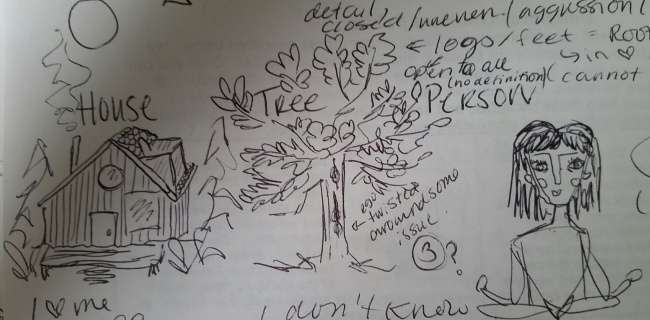The House-Tree-Person Test (HTP) is a projective technique designed to determine the main personality traits of a person who performs it. It’s often used during job interviews and different kinds of evaluations.
Draw a house, a tree, and a person. Now get ready to discover what your drawing can tell about your personality.

What’s being analyzed in your drawing?
The dimensions of the drawing represent your level of self-esteem and confidence.
Strokes and lines (their pressure, firmness, and solidity) indicate the level of determination and how comfortable you feel during a decision-making process. For example, if you tend to draw the same line twice, it shows insecurity, dissatisfaction, and out-of-control perfectionism.
Clarity represents harmony and flexibility.
1. The image of the house
The house represents family relations — how you see and interpret home and family life. It says a lot about how you feel about family values in general and your family in particular.
- Roof: represents the intellectual, fantasy, and spiritual life.
- Chimney: the affective and sexual life. Smoke coming out of the chimney symbolizes internal tension.
- Walls: the firmness and strengths of your personality.
- Door and windows: relationship with the surrounding world, social context, level of integration. For example, a very large door shows that you’re very dependent.
- Sidewalks: openness, access to your intimate family life.
- Ground: stability and contact with reality.
2. The image of the tree
The tree symbolizes the deepest and most unconscious aspects of your personality. It represents those things you usually keep to yourself.
- Crown: ideas, thoughts, self-concept. For example, crown density is directly connected with mental productivity.
- Branches: social contacts, aspirations, and level of satisfaction or frustration.
- Trunk: represents your sense of self, the intactness of your personality. If it’s curved, it means you’re flexible and adapt easily.
- Roots: related to your unconscious and instinctive inner world, reality testing, and orientation.
- Ground: contact with reality and stability. For example, its absence represents difficulties coping with reality.
3. The image of the person
The person represents self-concept, your ideal self. It shows your attitude toward this world, how your social life and inner world coexist.
- Head: intelligence, communication, imagination, sociability. For example, if the head is larger than the body, it means you have impressive intellectual abilities.
- Hair: sexuality, virility, and sensuality.
- Eyes: social communication and your perception of the world around you.
- Mouth: sensuality, sexuality, and verbal communication. If the mouth on your picture is just a straight line, it means you’re verbally aggressive.
- Nose: phallic symbol.
- Hands: affectivity, aggressiveness.
- Neck: impulse control.
- Arms: adaptation and integration with the social world.
- Legs: contact with reality, support, stability, and security.
- Feet: sexuality and aggressiveness.
BrightSide
More about: test
















































